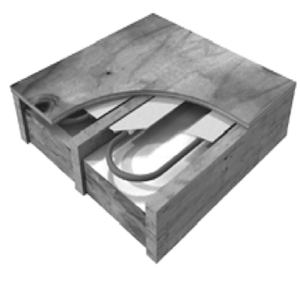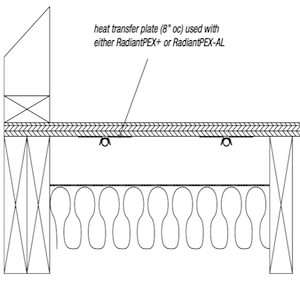Radiant Floor Heating Installation

Radiant Floor Heating Installation - Pex Piping
The concept of heating a room through the floor has been around for thousands of years. The ancient Romans and Greeks used wood fires to heat the floors of their baths, and the concept is still alive and well today in the form of radiant floor heating. The idea is simple: heat the floor and let the gentle, even heat radiate naturally up into the room rather than trying to make heat travel sideways through a fireplace, radiator, or wall vent.
Radiant heating works by using the entire floor as a giant radiator. Tubing is embedded in a lightweight concrete flooring, and warm water from a boiler circulates throughout the tubing, gently warming the floor. This is known as a 'wet' installation method. Another form of radiant floor heating uses electrical coils installed directly under floor for easier installation, known as a 'dry' installation.
There are many advantages to heating this way: it's virtually silent, there's no recirculation of dust and pollen through ductwork, there's no reduction in ambient humidity, and there can be a significant reduction in heating costs. A room's thermostat can be set 4 to 8 degrees cooler with radiant floor heating than with a typical forced air system while still providing the same level of comfort. The result is lower heating costs over time, and a reduction in energy usage.
Radiant Floor Heating Installation: Planning Ahead
As you're planning your radiant floor system, there are several factors to take into consideration in order to have a successful installation. A wet (hydronic) installation involves laying tubes for heated liquid into a wet surface such as concrete, which then hardens. This type of radiant system can add a significant weight load to a floor, which may make it unsuitable in some flooring situations. A dry installation method that uses electrically-heated systems is usually much lighter and doesn't require the use of a substrate like concrete, and can be used in areas where the wet systems would be too heavy.
Radiant Floor Heating Installation: Floor Covering Selection
Choosing the right material for the floor covering over a radiant heating system is important as well. Radiant heat can change the moisture content and temperature of floor coverings, and some types of floor coverings won't react well to these variations. Stone, ceramic, and porcelain tiles are all good choices for use with radiant heating.

Radiant Floor Heating Installation - Pex Piping
They conduct and hold heat very well, which is ideal for radiant flooring. Laminate flooring is another good option due to its stability. If you're considering a hardwood flooring for your radiant floor heating system, it's even more important to choose the right product. Hardwoods (including bamboo) can expand and contract quite a bit when subjected to changes in moisture and temperature, which can lead to floor damage.
Engineered hardwood floor materials are usually a better choice, as they are more stable. If your heart is truly set on a hardwood floor, follow these suggestions: use planks that are 3" wide or less. Select a very stable hardwood such as Tigerwood, Brazilian Cherry, or Ipe. These hardwoods will be more resistant to expanding and contracting. A 'floating' floor covering system is the easiest to install with a radiant heat system, as it eliminates the need for nails, staples, and adhesives, which allows the flooring material to expand and contract as a whole. While not recommended, it is possible to install carpet over a radiant floor heating system.
Choose a thin carpet with dense padding for the best results. You can also use vinyl or cork flooring, but keep in mind that the thicker the floor covering is, the harder (and longer) the system will have to work to reach the surface. Whichever flooring material you choose, it's always a good idea to check with the manufacturer's recommendations for its' use with radiant heating. Always follow manufacturer's recommendations to protect your floor covering and maintain it's warranty coverage. In Part Two, we will look at basic hydronic and electric installation methods.
comments powered by Disqus


























































































































































































